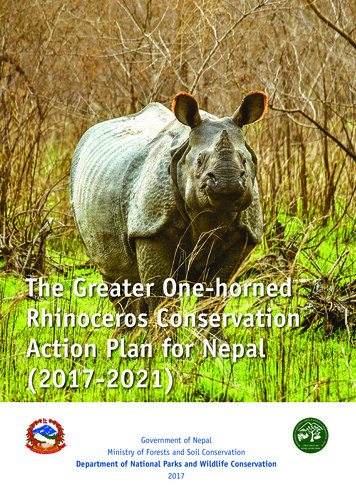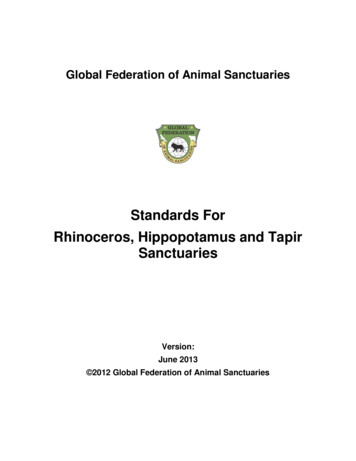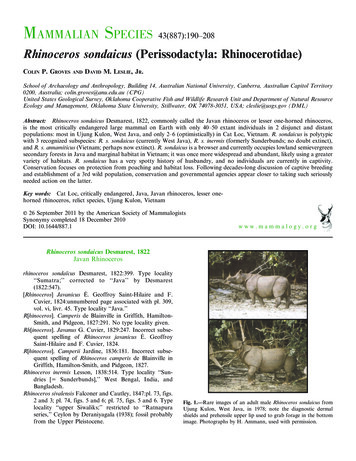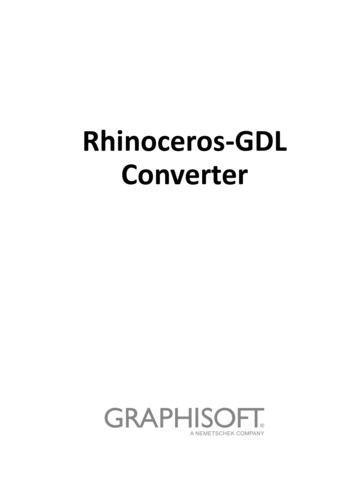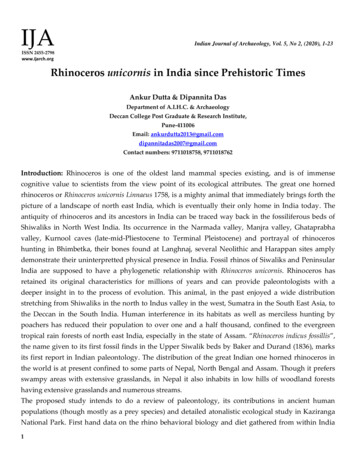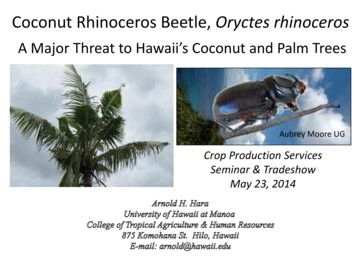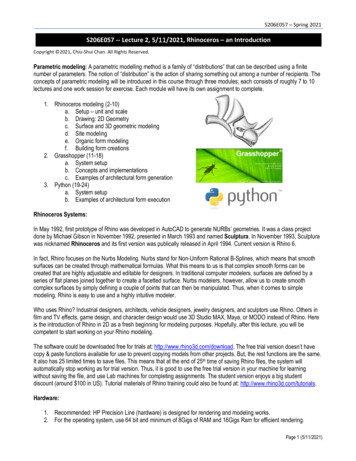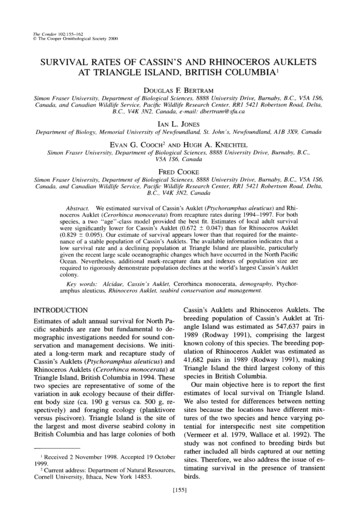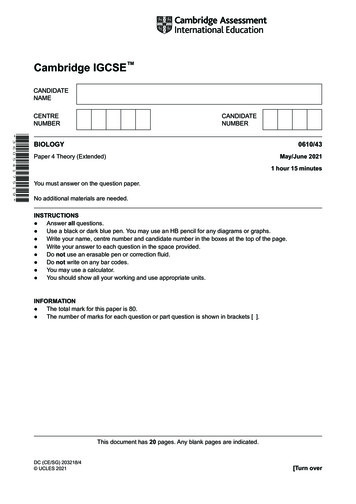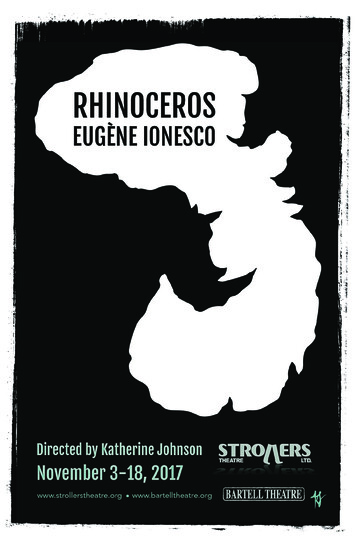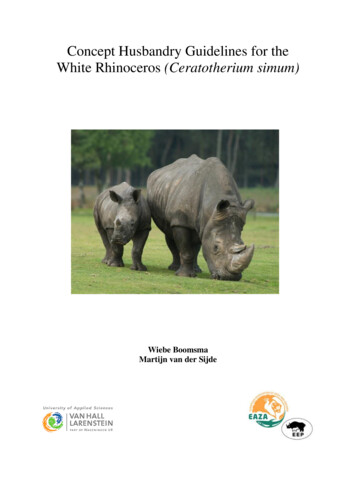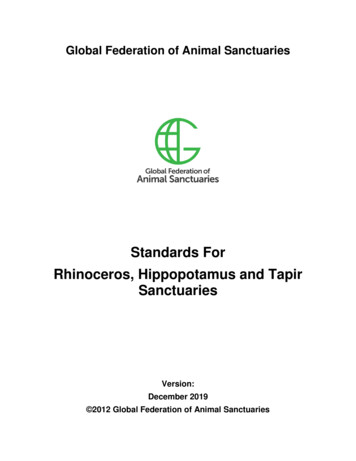
Transcription
Global Federation of Animal SanctuariesStandards ForRhinoceros, Hippopotamus and TapirSanctuariesVersion:December 2019 2012 Global Federation of Animal Sanctuaries
Global Federation of Animal Sanctuaries – Standards for Rhinoceros, Hippopotamus and TapirSanctuariesTable of ContentsINTRODUCTION. 1GFAS PRINCIPLES . 1ANIMALS COVERED BY THESE STANDARDS . 1STANDARDS UPDATES . 2RHINOCEROS, HIPPOPOTAMUS AND TAPIR STANDARDS . 2RHINOCEROS, HIPPOPOTAMUS AND TAPIR HOUSING. 3H-1. Types of Space and Size .3H-2. Containment .5H-3. Ground and Plantings.7H-4. Transfer Doors.9H-5. Shelter .10H-6. Enclosure Furniture .10H-7. Sanitation .11H-8. Temperature, Humidity, Ventilation, Lighting .12NUTRITION REQUIREMENTS . 14N-1. Water .14N-2. Diet .14N-3. Food Presentation and Feeding Techniques .16N-4. Food Storage .17N-5. Food Handling .17VETERINARY CARE. 18V-1. General Medical Program and Staffing .18V-2. On-Site and Off-Site Veterinary Facilities .18V-3. Preventative Medicine Program .19V-4. Clinical Pathology, Surgical, Treatment and Necropsy Facilities .20V-5. Quarantine and Isolation of Rhinoceros, Hippopotamus and Tapirs .21V-6. Medical Records and Controlled Substances .22V-7. Breeding/Contraception .23V-8. Zoonotic Disease Program.24V-9. Euthanasia 30WELL-BEING AND HANDLING OF RHINOCEROS, HIPPOPOTAMUS AND TAPIRS . 25W-1. Physical Well-Being .26W-2. Social Housing .27W-3. Introduction of Unfamiliar Individuals .27W-4. Behavioral/Psychological Well-Being .28W-5. Rhinoceros/Hippopotamus/Tapir-Caregiver Relationships . . 29W-6. Handling and Restraint.30i
Global Federation of Animal Sanctuaries – Standards for Rhinoceros, Hippopotamus and TapirSanctuariesW-7. Animal Transport . 37RHINOCEROS, HIPPOPOTAMUS AND TAPIR BEING RELEASED TO THE WILD . 31R-1. General Considerations .32R-2. Rescue Of Rhinoceros, Hippopotamus and Tapirs .33R-3. Evaluation Of Suitability For Release .34R-4. Quarantine And Prerelease Housing .34R-5. Diet, Nutrition And Foraging Skills .36R-6. Husbandry And Health .36R-7. Health And Safety Of Caregivers Working With Releasable Rhinoceros, Hippopotamus and Tapirs .37R-8. Assessment of Health and Skills .38R-9. Determining Appropriate Release Sites .60R-10. The Release Process And Post Release Monitoring.60APPENDIX 1 . 40ii
Global Federation of Animal Sanctuaries – Standards for Rhinoceros, Hippopotamus and TapirSanctuariesINTRODUCTIONGFAS PRINCIPLESThe Global Federation of Animal Sanctuaries (GFAS) will designate an organization as “verified” or“accredited” based upon its substantial compliance with the standards listed below. GFAS recognizes thatsome organizations under consideration will operate valid rescue and rehabilitation programs with a goalof releasing wildlife to the wild pursuant to IUCN and/or other international or national standards. Forthose animals, lifetime sanctuary care may not be part of the organization’s mission. While the care forthese animals may be provided on an interim basis only, the organization is still expected to meet thestandards below with regard to all animals in its care and for purposes of these standards it will beidentified as a “sanctuary.”Consistent with GFAS’ philosophy and the standards below, it is expected that a sanctuary does notadopt policy positions that are in opposition to the welfare of the species of animals in the care of thesanctuary (for example, while it is not required that a primate sanctuary affirmatively promote a policyagainst laboratory research using primates, it should not promote a policy in favor of such research).Note: Several standards make reference to a sanctuary’s “Director.” GFAS recognizes that a sanctuarymay use a different title, and the term “Director” is intended to reference the sanctuary’s SanctuaryDirector, who may be called an Executive Director or Chief Executive Officer, etc.GFAS also recognizes that sanctuaries may rely on volunteers for certain functions, including someaspects of animal care (such as food preparation). Standards referencing “staff” may take into accountappropriately qualified and trained volunteers as well as employees.Appendix I of this document provides further guidance/suggestions on facility design and rhinoceros,hippopotamus and tapir care. These are not requirements but rather provide sanctuaries with access toknowledge gained from experience at other sanctuaries/rhinoceros, hippopotamus and tapir carefacilities.ANIMALS COVERED BY THESE STANDARDSFamily/Genus/ Species/Common NamesFamily: Hippopotamidae, Rhinocerotidae, ueCommon Namewhite rhinoceros, northern white rhinoceros, square-lippedrhinocerospygmy hippo, pygmy hippopotamusSumatran rhinocerosblack rhinoceros, hook-lipped rhinoceroshippopotamus, hippo, large hippoJavan rhinocerosIndian rhinoceros, greater one-horned rhino, Greater IndianrhinocerosBaird’s tapir, Central American tapirAsian tapir, Indian tapir, Malayan tapir, Malay tapirmountain tapir, Andean tapir, woolly tapir1
Global Federation of Animal Sanctuaries – Standards for Rhinoceros, Hippopotamus and TapirSanctuariesTapirusterrestrislowland tapir, Brazilian tapir, South American tapirVersion Updates:New and Updated content released on February 2015 G-1 Nonprofit/ Non-Commercial Status, P-3 Disposition Ethics and Responsibility, P-4Disposition of Live Rhinos, Hippos, and Tapirs, P-5 EuthanasiaNew and Changed content released on July 2015 V-7 Breeding/Contraception – section a.2
Global Federation of Animal Sanctuaries – Standards for Rhinoceros, Hippopotamus and TapirSanctuariesRHINOCEROS, HIPPOPOTAMUS AND TAPIR STANDARDSGFAS notes that there may be other acceptable ways of meeting the intent of each standard, aside fromthose detailed below, and that in some instances there may be legal, cultural or other significant barriersto meeting GFAS requirements. The standards are considered mandatory, but GFAS will considerspecific exceptions to some of the listed requirements (e.g., exact enclosure size, manner of recordkeeping, legal requirements that impact a sanctuary’s acquisition policy, etc.). GFAS encouragessanctuaries to offer feedback on the standards and to explain any reasons why it believes it cannot meeta particular standard, or why the standard is not applicable and/or appropriate to its situation. Sanctuariesare also welcome to indicate a timeline for meeting a standard if the standard is not yet met at the time ofapplication for accreditation or for verification.The exceeding of the standards is encouraged. In addition to meeting these standards, an organization isexpected to comply with all applicable international, national, state/province, and local laws andregulations.RHINOCEROS, HIPPOPOTAMUS AND TAPIR HOUSINGH-1. Types of Space and SizeUnless otherwise directed by a veterinarian, rhinos, hippos and tapirs are providedsufficient opportunity and space to move about freely and rapidly, and to exercisechoice in location so as to reduce stress and maintain good physical condition.Generala. The habitat and living conditions are species appropriate and replicate, in as much as possible, therhino, hippo and tapir wild habitat with a balance between hygiene and the species’ physiological andpsychological needs. This includes adequate and appropriate space, in terms of diversity andcomplexity.b. The physical space provides varied opportunities for the rhinos, hippos and tapirs to interact with theenvironment and key elements are changed often, resulting in a dynamic living space.c.Facility design takes into account caregiver-animal safety and ease of maintaining a positiverelationship.d. Rhinos, hippos and tapirs are provided access to as many areas of the enclosures as possible,except during staff maintenance activities, unless security concerns dictate otherwise. All enclosuresinterconnect without creating 'dead ends' to allow for freedom of movement of subordinateindividuals.e. Outdoor enclosures are either covered, with minimum height to allow for natural behaviors, or openroofed with sufficient height to prevent escape (see Housing Dimensions for appropriatemeasurements).f.The habitat provides appropriate visual, olfactory, and acoustic barriers.g. The habitat provides security from predators and unauthorized human access.Open Space Settingsh. Open space enclosures, which may be indoor or outdoor units, are designed to provide the maximumpossible freedom and complexity for enclosure residents. The enclosures have sufficient area peranimal to accommodate natural individual and group activities. While it may not be possible to3
Global Federation of Animal Sanctuaries – Standards for Rhinoceros, Hippopotamus and TapirSanctuariesmonitor every animal in an Open Space enclosure on a daily basis, design allows for regularinspection of animals and facility maintenance as needed.i.Where open space settings are the primary enclosure, the following are also provided: Shelter which can serve as night housing and/or secure space during inclement and extremeweather. Space for use while the primary enclosure is serviced and/or for animal management needsincluding introduction of new individuals to a group, or temporary separation for health or socialreasons. (Note: This space might also be night housing, lockout, shift yard, etc.) Alternate housing for sick or injured individuals.Controlled access settingsj.Controlled access enclosures, which may be indoor or outdoor units, provide sufficient space fornatural activities but are also designed to allow caregivers to monitor each individual animal on a dailybasis, to easily shift individuals, pairs or small groups as needed and to isolate animals for individualcare. As with Open Space enclosures, design also includes: Shelter which can serve as night housing and/or secure space during inclement and extremeweather. Space for use while the primary enclosure is serviced and/or for animal management needsincluding introduction of new individuals to a group, or temporary separation for health or socialreasons. (Note: This space might also be night housing, lockout, shift yard, etc.) Alternate housing for sick or injured individuals.Indoor Housingk.Indoor housing provides year-round protection from the elements. For sanctuaries located in colderclimates (where freezing temperatures occur regularly during any part of the year and temperate ortropical species are housed), indoor space is insulated and is large enough to allow for all forms ofspecies-specific behavior (running, swimming, digging/wallowing, playing, etc.).Dimensionsl.Many factors influence the minimum space required for a group of rhinoceros, hippopotamus ortapirs, including, but not limited to: group size, group composition, and enclosure complexity. Thefollowing guidelines are minimum recommendations. Facilities should provide as much space as ispossible and/or practical.m. Sanctuaries meeting only the minimum requirements for enclosure space employ additionalenvironmental enrichment, focusing on physical and mental exercise rather than food, to compensatefor reduced space and complexity. The use of a rotation system, which allows groups and/or individual rhinos, hippos and tapirs toregularly spend time in a larger or different space, is strongly encouraged in these circumstancesto increase enrichment and encourage activity. Outdoor enclosures for rhinoceros, hippopotamus and tapirs - Enclosure shape may be variableto take in natural features in the landscape such as rock formations, hills and trees. Particularattention is paid to providing water features such as mud wallows, ponds and/or pools, forthermoregulation and enrichment. Space includes a minimum of one (1) animal transfer doorleading to indoor shelter.oMinimum of 10,000 sq. ft. (929 sq. m) per adult rhinoceros/hippopotamus.oMinimum of 3,230 sq. ft. (300 sq. m) per pair of adult tapir/pygmy hippo.oMinimum vertical dimension of 5 ft. (1.5 m) for all species.4
Global Federation of Animal Sanctuaries – Standards for Rhinoceros, Hippopotamus and TapirSanctuariesn. Indoor enclosures/shift yards for rhinoceros, hippopotamus and tapirs - A minimum of two indoorareas or one indoor enclosure and one shift yard per adult rhino or hippo or pair of adult tapir orpygmy hippo, with a minimum of two doors to adjacent enclosures. Room dimension is dependent onintended purpose and/or duration of confinement. Space includes water features for animals beinghoused long term. Includes two rooms or one room and a shift yard with minimum dimensions of 2000 sq. ft. (92.9sq.m) per adult rhinoceros or hippopotamus. Includes two rooms or one room and a shift yard with minimum dimensions of 538 sq. ft. (50 sq.m) per pair of adult tapirs or pygmy hippopotamus. Rooms and shift yards interconnect without creating ‘dead ends’ to allow for freedom ofmovement for subordinate individuals and include a minimum of two transfer doors per room/shiftyard to the main outdoor enclosure. Where animals are housed indoors long term, e.g. in northern climates where freezingtemperatures occur regularly, indoor space is large enough to accommodate all forms of speciesspecific behavior (running, wading/wallowing, swimming, etc.) Rhinoceros, hippopotamus and tapirs may be familiarized with rooms and shift yards throughroutine feeding in or transfer through, or by being allowed continuous access. Whenever possible and species appropriate, separated animals have visual and tactile access togroup members to facilitate reintroduction.o. Mixed species housing Where multiple species share an enclosure, the total dimension is adjusted to reflect theminimum spatial requirements of each species housed. Minimum indoor dimensions remain unchanged for each species. Each species has a dedicated transfer door between indoor and outdoor enclosures. Mixed species groupings are appropriately researched to ensure compatibility and to avoidunnecessary stress for all species.H-2. ContainmentRhinoceros, hippopotamus and tapirs are safely contained.Generala. Other than when being transported or for medical reasons, rhinos, hippos and tapirs are kept at alltimes in secure enclosures or other appropriate areas.b. Enclosures are designed to allow for animals ' normal defense reactions and appropriate 'flight' orescape distances.c.All enclosures are designed, constructed and maintained to securely contain rhinos, hippos and tapirsand to present no likelihood of harm to them.d. Distance or barriers between animals and between enclosures and personnel is sufficient to minimizestress to the animals, as well as reduce the risk of disease transmission. Clear markings delineating safe zones or transparent barrier such as plexiglass or lexan are usedin areas where caregivers must work in close proximity to cages.e. Enclosures are designed to allow for proper, safe cleaning and drainage.f.A regular program of sanctuary maintenance is in place.5
Global Federation of Animal Sanctuaries – Standards for Rhinoceros, Hippopotamus and TapirSanctuariesg. Materials are appropriate for their particular application and are maintained in good repair.Outdoor Enclosuresh. Perimeter containment of outdoor areas is constructed so as to prevent digging under the barrier bynative wildlife, domestic species and the enclosure residents.i.Fences and enclosures are inspected daily for signs of digging. Where fencing meets hard surfacessuch as rock or concrete, the fencing is securely anchored in place.j.Design takes into account natural behaviors of species housed.Fencingk.Barbed or razor wire are not used to contain rhinoceros, hippopotamus or tapirs.l.The supporting posts for fences are firmly fixed into the ground.m. Fence material is sufficiently secured to supporting posts in such a way that the weight of the rhinos,hippos and tapirs could not detach it from the support nor dislodge the supporting posts.n. Gates and doors are at least as strong, and as effective, in containing the animals as the rest of theenclosure barriers. In particular gates and doors are designed and maintained so as to preventanimals from lifting them from their hinges or unfastening the securing device. All containment barriers have a mechanism to prevent rhinos, hippos and tapirs from gainingaccess to uproot fencing with their horns.o. Dimensions Horizontal or vertical fencing of concrete, steel pipe or steel cable may be used to contain rhinos,hippos and tapirs.oMinimum vertical dimension of 5 ft. (1.5 m).oVertical fencing recommended to reduce risk of animals uprooting fencing with their horns.oChain link may be used to contain tapirs but is not recommended for rhino and hippoenclosures. 9 gauge or heavier recommended.Electric Fencingp. Electric fence energizers emit at least 9,000 V with a joule rating appropriate for the length andcondition of the fence (25 joules is recommended).q. 20-gauge high-tensile wire is required. A stronger gauge (e.g., 12-gauge), may be more appropriatefor some species.r.Fences are a minimum of 12 ft. (3.66 m) tall, with a maximum wire spacing of 4 in. (101.6 mm) for thefirst 4 ft. (1.22 m) and 6 in (152.40 mm) thereafter.s.Fence is alternating hot/ground.t.Energizers are connected to battery or generator backup for continuous power supply during outages.u. In dry climates, the earth rod area is watered to ensure adequate grounding.v.If using electric fence as a primary barrier, two separate complete systems are used to increaseeffectiveness and reduce the chance of system failure.w. Enclosure furniture is placed at a safe distance from the fence to prevent accidental contact byrhinos, hippos and tapirs.x.Safety signs on hot wire are visible to staff and bystanders.6
Global Federation of Animal Sanctuaries – Standards for Rhinoceros, Hippopotamus and TapirSanctuariesy.A non-electrified barrier is used to keep bystanders and wildlife from coming in contact with theelectric fence.Solid Barriersz.Solid barriers such as concrete block, poured concrete and artificial rock can be used as the solemethod of containment or in conjunction with other types of barrier.aa. Walls are secured in appropriate footings to ensure wall stability, and are of sufficient strength toanchor caging and furniture.bb. Height of the wall is the same as that for fences.cc. Design of areas using solid walls allows for sufficient air flow throughout an enclosure.Moatsdd. Moats are used with caution due to risk of animals becoming trapped.ee. Moats, constructed with one steep side and one gently sloping side designed for easy access in orout, are acceptable for containment of rhinos, hippos or tapirs. Animals do not have access to themoat from the steep side.Indoor Enclosures and Shift Yardsff. Walls may be constructed of concrete, vertical posts or steel corral type pipe. Tapir shift yards may be constructed with chain link as described in the outdoor enclosuresection. Solid walls of concrete or wood may be used in rhinoceros enclosures to prevent visual contactbetween animals. Walls are of sufficient strength to contain the animals.H-3. Ground and PlantingsGround cover indoors and out is healthy for rhinoceros hippopotamus and tapirs.Plantings are appropriate and safe.Vegetationa. Any vegetation capable of harming rhinos, hippos and tapirs is kept out of reach.b. Trees within or near animal enclosures are regularly inspected, trimmed or felled as necessary toavoid animals being harmed by falling branches, toxicity, or trauma.c.Access to very tall trees which are useful for shade limited by electric wires, barriers etc. to preventtheir being damaged by the rhinos, hippos or tapirs.d. Any natural materials (e.g., plants and their products, such as seeds or fruit) are assessed for toxicityto the species held before use.Outdoor enclosurese. All outdoor enclosures have a natural substrate consistent with the needs of the species. The substrate provides easy to clean, dry areas for feeding. The substrate can be amended with organic materials, including but not limited to soils, sand, leaflitter, bark mulch, grasses, straw and hay.7
Global Federation of Animal Sanctuaries – Standards for Rhinoceros, Hippopotamus and TapirSanctuariesf. Sand or gravel with regular access to grassy areas is recommended for hippopotamus and Indianrhinoceros. The substrate drains well.Rhinoceros, hippopotamus and tapir are provided with species appropriate environments toaccommodate an array of locomotory and foraging behaviors, as well as appropriate sleeping andresting areas.g. Rhinoceros, hippopotamus and tapirs are provided with appropriate water features/mud wallows andwater quality is monitored where water sources are not ‘dump and fill’. Water features are designed such that animals are not at risk of being unable to safely enter andexit the water and are of a species appropriate depth.h. Where natural topography of an enclosure is not varied, it is created through the addition of naturaland placed elements.Indoor enclosuresi.j.Indoor enclosures have a non-slip concrete floor and, provided adequate septic service is present,the floor is sloped to a drain. Natural substrate, which is routinely replaced, is used as speciesappropriate. Bark mulch, leaf litter, straw, hay and wood shavings may be used for tapirs. Sand is recommended for rhinoceros and hippopotamus.For new construction, the indoor area is designed to accommodate a deep litter substrate forrhinoceros, hippopotamus and tapirs. Deep litter enclosures are designed to allow appropriate litter depth and drainage for properfunctioning. Litter is properly spot-cleaned and maintained.k.Existing construction ensures that all floors are sealed.l.Bedding materials are provided in sufficient amount/depth to prevent contact with the concrete. Bedding material suitable for use includes, but is not limited to, bark mulch, leaf litter, wood wool,straw hay, shredded paper and wood shavings.oSand is recommended for rhinos and hippos.m. Rhinos, hippos and tapirs are provided with water sources/mud wallows when climate requires themto be housed indoors for extended periods.n. All animals are observed regularly for signs of illness that may be related to ingestion of foreignobjects, including wood shavings, bark mulch or other materials that may pose a hazard.Shift yardso. All outdoor shift yards have a minimum of 70% of the surface area in natural substrate. The remaining30% may be concrete as appropriate for drainage, sanitation and structural needs. Sand and grasses or other grazing plants recommended.p. The substrate can be amended with organic materials including, but not limited to, soils, sand, leaflitter, bark mulch, grasses, straw and hay, as species appropriate. The substrate drains well.q. Bedding materials are provided in sufficient amount/depth to prevent direct contact with any concretesurfaces.r.Shift yards which house animals for extended periods include species appropriate water features/mudwallows.8
Global Federation of Animal Sanctuaries – Standards for Rhinoceros, Hippopotamus and TapirSanctuariesH-4. Transfer DoorsRhinoceros, hippopotamus and tapir transfer doors are appropriately designed toensure both animal and human health and safety.Generala. Animal transfer doors are a key element of facility design.b. Doors are designed to allow transport crates to safely attach to them.c.Transport crates should be able to be moved in and out of the enclosure through the transfer doors.d. Transfer doors are designed to remain functional under all circumstances, are maintained in goodworking order and free from any encumbrances that may prevent opening and closing.e. Doors are designed to allow caregiver view of enclosures while operating the doors.f.Minimum dimensions of transfer doors are such that the largest animals in the enclosure can maintainnormal posture when passing through the opening.g. Doors are designed such that people are out of view when animals are being shifted. If not, no eyecontact is made with the animals going through the doors.h. Doors and door hardware are properly maintained to ensure proper functioning.Securityi.Transfer doors and their frames are constructed of materials similar in strength to those used in theprimary enclosure.j.Doors are lockable in both the open and closed positions.k.For pneumatic or hydraulic doors, pneumatic or hydraulic pressure is sufficient for keeping doors inthe open position
o Minimum of 10,000 sq. ft. (929 sq. m) per adult rhinoceros/hippopotamus. o Minimum of 3,230 sq. ft. (300 sq. m) per pair of a
